Where to dig in?
Looking to start gardening? Begin with proper containers with drainage holes and quality potting soil for container gardens. Choose plants based on your season—cool-weather crops for spring, heat-loving plants for summer. Gather essential tools: gloves, trowel, pruning shears, and watering can. Practice water-wise techniques by selecting drought-tolerant plants and using drip irrigation. Prepare soil by loosening it and adding compost for better plant growth. The foundation you build now, learning about basic gardening ideas, will yield beautiful results throughout your gardening journey.
Container Gardening for Beginners
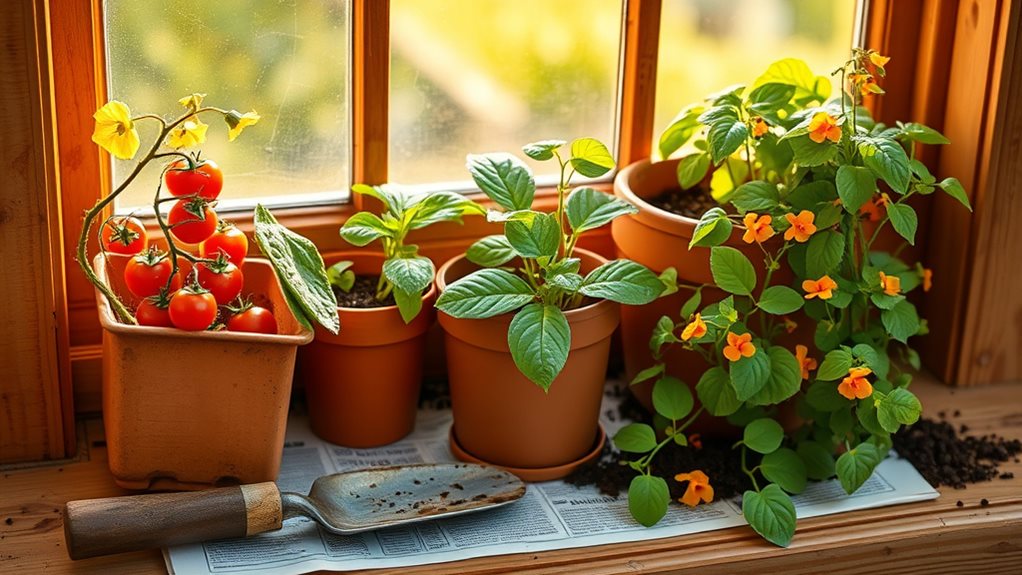
Often, container gardening offers the perfect solution for beginners and those with limited space to grow their favorite plants. You’ll need to select appropriate containers with drainage holes to prevent waterlogging—if your container lacks them, you can easily drill some yourself.
Choose your container materials wisely:
- Plastic: Lightweight and affordable
- Clay: Breathable but heavier
- Wood: Natural look but requires maintenance
- Metal: Durable but can overheat
When selecting plants, consider combinations with similar light and water needs. Most vegetables, annuals, perennials, and even dwarf fruit trees thrive in containers. Succulents thrive particularly well and create spectacular displays in container gardens. Avoid using ordinary topsoil as it quickly compacts and lacks essential nutrients for container plants. Fill containers with quality potting soil specifically designed for container gardening, and remember to fertilize weekly as nutrients deplete faster than in ground soil.
Seasonal Planting Guide
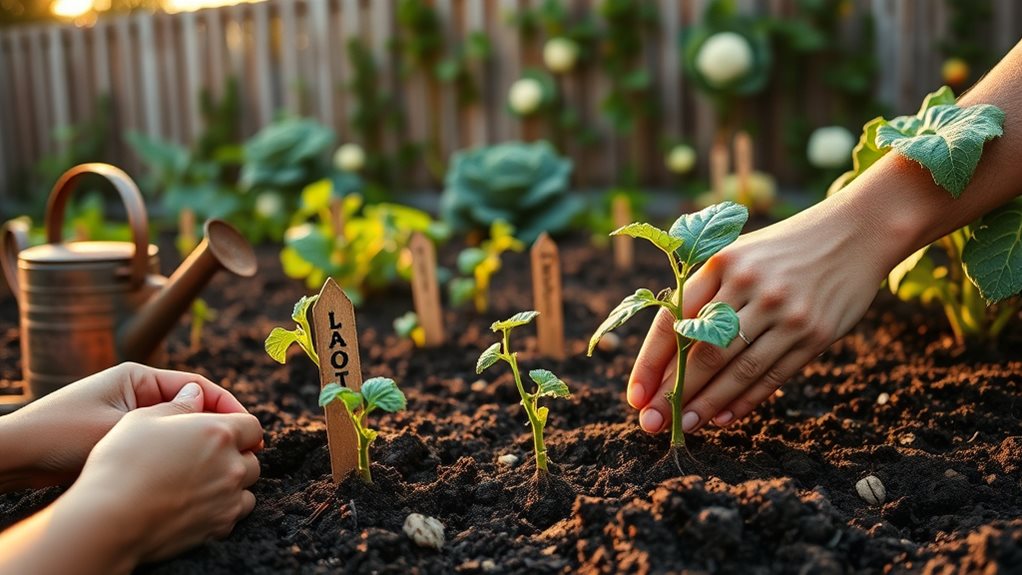
While container gardening offers flexibility year-round, successful gardening also depends on understanding when to plant different crops. Your garden’s productivity relies on working with nature’s calendar rather than against it.
Spring Planting (March-May)
- Plant cool-weather vegetables like broccoli, cauliflower, and spinach
- Prepare soil by checking pH levels (aim for 6.0-7.0)
- Monitor frost dates in your hardiness zone before planting sensitive crops
- Consider starting with raised beds for better soil control and drainage, especially if you’re a beginner.
Summer Planting (June-August)
- Shift to heat-loving plants like tomatoes, peppers, and cucumbers
- Maintain consistent watering schedules, especially during hot periods
- Consider adding shade protection during intense afternoon sun
Fall/Winter Planning
- Plant hardy vegetables like carrots and Brussels sprouts in fall
- Install bulbs in autumn for spring flowering
- Move to indoor herb and microgreen cultivation during winter months
- Plan your spring garden layout ensuring tall vegetables are positioned on the north side to prevent unwanted shading of smaller plants.
Essential Tools for New Gardeners
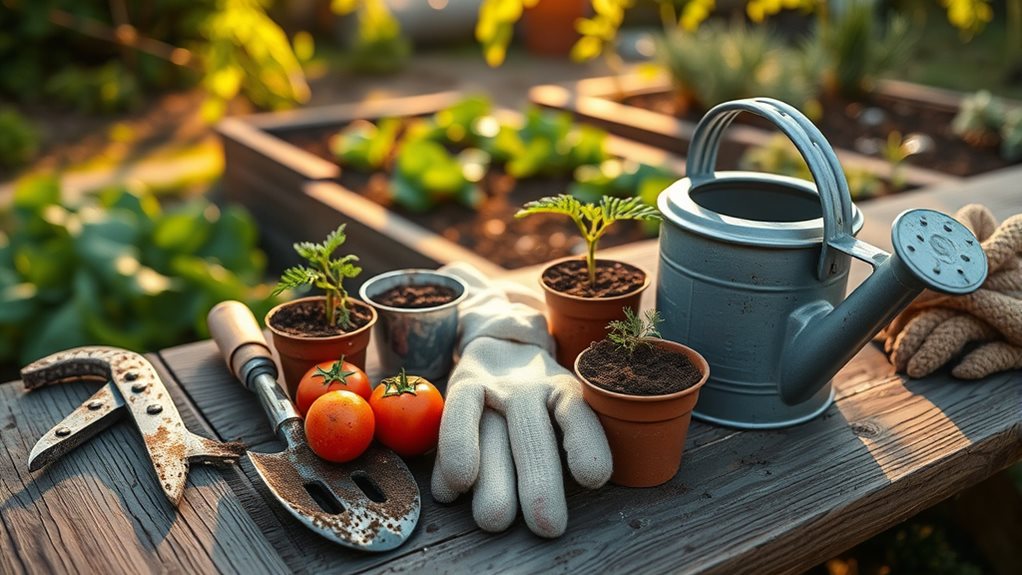
Starting your gardening journey requires the right set of tools, which will make your work easier and more enjoyable. You’ll need protection for your hands, implements for soil preparation, and equipment for plant maintenance. Begin with these fundamental categories to build your collection. Regular maintenance with cutting tools allows you to control plant size and encourage healthy new growth. Look for tools made with durable materials like hardened steel or forged aluminum for long-lasting performance in your garden.
| Category | Must-Have Tool | Best For |
|---|---|---|
| Hand Tools | Gardening Gloves | Protecting hands from soil and thorns |
| Digging | Hand Trowel | Transplanting seedlings and small plants |
| Cutting | Pruning Shears | Trimming stems and small branches |
| Maintenance | Watering Can | Controlled plant watering |
| Comfort | Kneeler Pad | Reducing strain on knees and back |
Don’t feel you need everything at once. Start with these essentials and add specialized tools like loppers, garden forks, or wheelbarrows as your garden grows and your skills develop.
Water-Wise Gardening Techniques
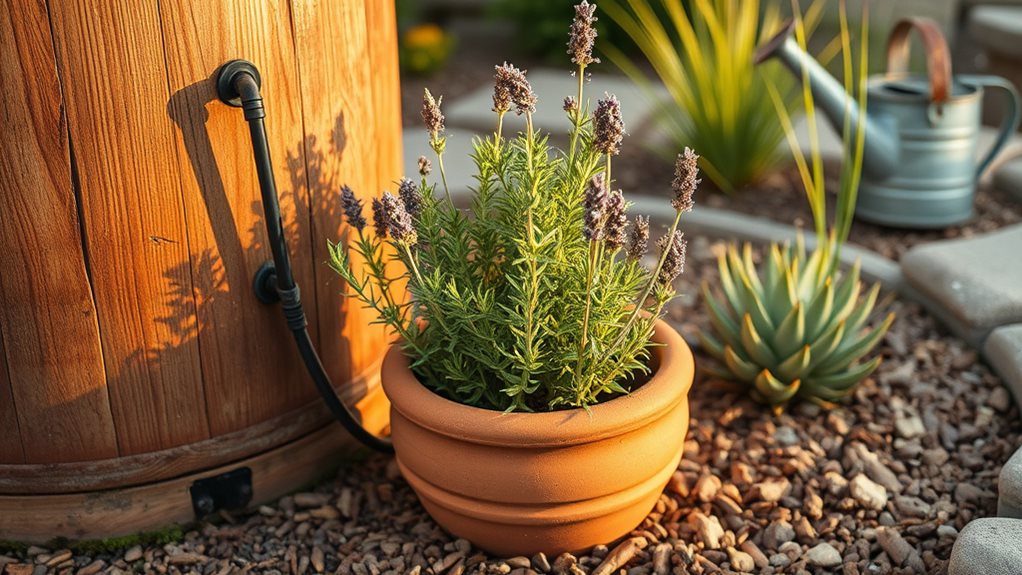
As water becomes a more precious resource, adopting water-wise gardening techniques isn’t just environmentally responsible—it’s also budget-friendly. Start by selecting native and drought-tolerant plants that thrive in your local climate with minimal watering.
Improve your soil by adding compost and organic matter, which enhances water retention and reduces the need for frequent irrigation. Consider incorporating a no-till approach to preserve soil structure and increase its water-holding capacity. Consider incorporating wildflowers that are not only highly drought-tolerant but also support local pollinators. Group plants with similar water needs together in designated zones to prevent overwatering some while underwatering others.
For efficient watering:
- Install drip irrigation or soaker hoses to deliver water directly to roots
- Apply mulch to reduce evaporation and suppress weeds
- Water deeply but infrequently to encourage deeper root growth
- Monitor soil moisture and adjust your watering schedule seasonally
Regular maintenance, including weed control and system inspections, will maximize your water conservation efforts.
Soil Preparation Fundamentals
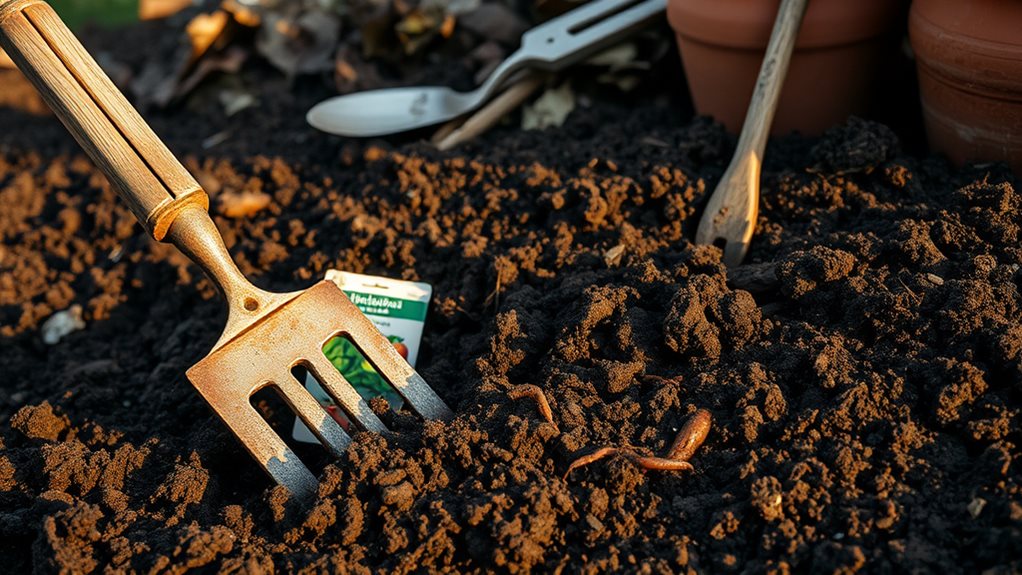
The foundation of every successful garden lies in properly prepared soil, which provides essential nutrients, drainage, and structure for healthy plant growth. Begin preparation by selecting a spot that receives 6-8 hours of sunlight daily, and test your soil’s pH (aim for 6.0-7.2).
Healthy soil is a garden’s lifeblood, delivering nutrients and support while creating the foundation for thriving plants.
Follow these essential steps:
- Remove existing vegetation completely
- Loosen soil to at least 8 inches deep
- Add 1-2 inches of compost or aged manure
- Incorporate organic matter until you reach about 5% content
- Avoid working wet soil to prevent structural damage
Test for compaction by trying to push a garden fork into the soil. If it’s difficult, your soil needs more loosening. For accurate soil assessment, conduct a DIY jar test to determine whether your soil is primarily clay, sandy, or silt-based. Loamy soil is considered ideal for gardening due to its balanced composition that provides excellent drainage while retaining moisture. Remember to add fresh compost annually, and consider planting cover crops during off-seasons to maintain fertility naturally.
Companion Planting Strategies
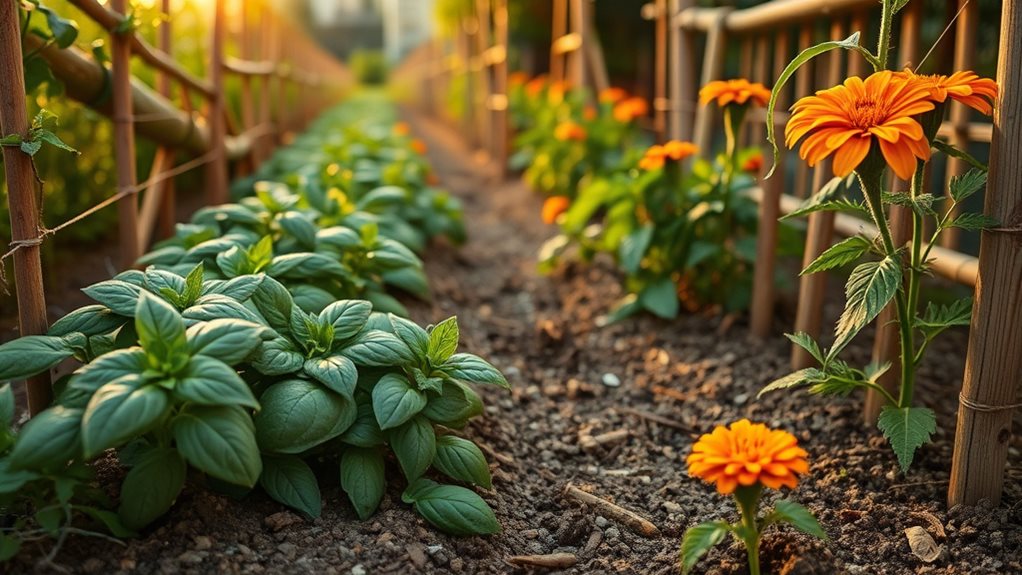
With your soil properly prepared, you can now enhance your garden’s productivity through strategic plant partnerships. Companion planting maximizes space while naturally controlling pests and improving soil health. You’ll notice higher yields when you pair plants that benefit each other, rather than competing for the same resources. Before implementing your companion planting strategy, ensure you’ve selected a location with sunlight adequate for your chosen vegetable varieties.
Try these proven companion combinations:
- Plant marigolds near tomatoes to repel harmful nematodes
- Grow beans alongside corn for natural support and nitrogen fixation
- Position basil next to peppers to improve their flavor
- Use nasturtiums as a sacrificial crop near cabbage to attract pests away
- Interplant quick-growing radishes between slower vegetables to maximize space
These partnerships work because they either repel unwanted insects, attract beneficial ones, or create mutually beneficial growing conditions. Native Americans perfected the Three Sisters technique combining corn, beans, and squash for optimal growth and nutrition. Start with these basic combinations, then experiment with others as you gain experience.
Garden Design for Small Spaces

Limited space shouldn’t prevent you from creating a beautiful, productive garden. By implementing smart design principles, you’ll maximize every inch of your compact outdoor area.
Small spaces hold big gardening potential—it’s all about clever design that maximizes every inch.
Maximizing Small Gardens
- Optimize vertical space with trellises and wall-mounted planters to grow more plants upward rather than outward
- Choose compact or dwarf plant varieties specifically bred for small spaces
- Use raised beds and containers to improve soil quality and make maintenance easier
- Design narrow pathways to save space for more plantings
- Incorporate multipurpose features like benches with built-in storage
For a minimalist approach, stick with neutral colors and simple layouts. Add visual interest through bold plant designs and strategic lighting. When planning your garden layout, consider including a comfortable seating area sized for day-to-day use rather than occasional large gatherings. Using graph paper to sketch your small garden can help you visualize the space and prevent common design mistakes. Remember, even tiny gardens can include functional elements like small seating areas and water features that transform limited space into an enjoyable retreat.
Natural Pest Management

Maintaining a thriving garden doesn’t require harsh chemicals, as natural pest management offers effective alternatives that protect both plants and beneficial insects. You’ll find that integrating physical barriers like insect screens alongside strategic companion planting creates a robust defense system against unwanted visitors.
Try these proven natural pest control methods:
- Mix your own organic sprays using neem oil or garlic to target specific pest problems
- Introduce beneficial predators such as ladybugs and lacewings to combat aphids naturally
- Plant pest-repelling herbs like basil, rosemary, and lavender throughout your garden
- Apply diatomaceous earth around vulnerable plants to deter crawling insects
- Use sticky traps to monitor and reduce flying pest populations without chemicals
For slug problems, setting up simple beer traps can effectively attract and drown these garden pests without using commercial chemicals.
Regularly pruning affected plant parts and improving soil health with compost will further strengthen your garden’s natural resistance to pests. Creating a backyard compost bin with both green and brown materials provides nutrient-rich soil amendments that naturally boost plant immunity against common pests.
Simple DIY Garden Projects
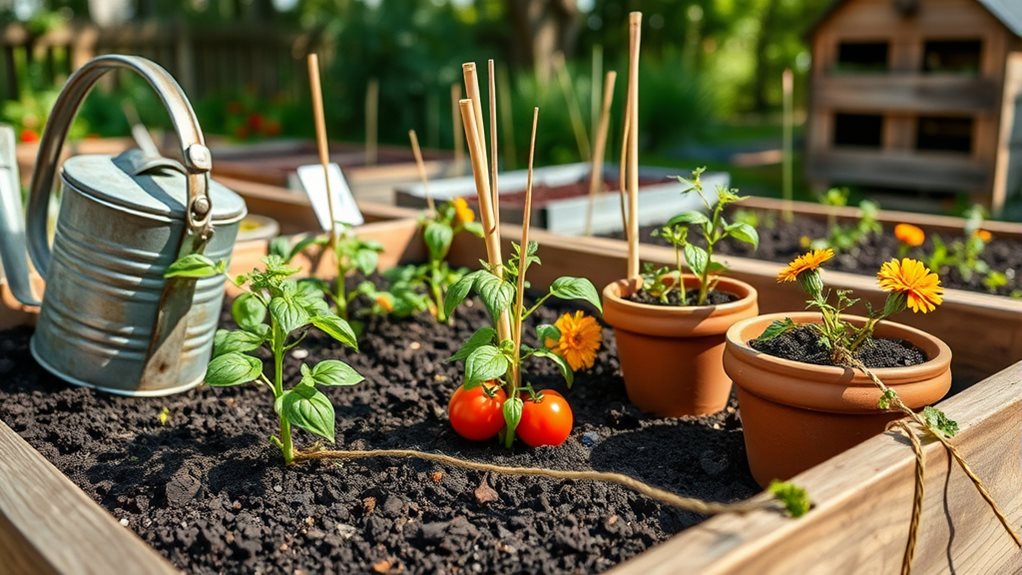
Transforming your outdoor space into a beautiful garden doesn’t require expensive materials or professional help, as many creative projects can be completed using items you already have around the house. Consider starting with container gardening, which is perfect for small spaces and allows you to experiment with different plants.
For an elegant yet low-maintenance option, combine gravel ground cover with strategically placed potted plants to reduce lawn care while maintaining visual interest. Raised beds offer better drainage for vegetables, while vertical gardening maximizes limited space by growing upward. You can repurpose old wooden crates into planters or create decorative trellises that support climbing plants like beans and peas.
For a practical touch, install a rain barrel to collect water for irrigation, saving on water bills during dry months. If you live in a region with a tropical climate, like Florida, choose heat-tolerant plants that thrive in bright sunlight and ocean breezes. Garden lighting, especially solar-powered options, highlights your plants at night without increasing electricity costs.
These simple projects combine functionality with beauty, making your garden both productive and enjoyable.
Frequently Asked Questions
How Do I Attract Beneficial Insects to My Garden?
- Plant a variety of herbs like dill, fennel, and parsley, which provide nectar and pollen that beneficial insects love.
- Include fragrant flowers such as lavender and marjoram to draw in butterflies and pollinators.
- Guarantee year-round blooms by planning seasonal plantings.
- Add umbelliferous plants that attract lacewings and hoverflies.
- Create diversity with wildflowers, which will increase the range of helpful insects in your garden.
What Gardening Activities Can Children Safely Participate In?
You can involve children in many safe gardening activities that build skills while creating lasting memories. Try:
- Seed planting in small pots with child-sized tools
- Creating fairy gardens with miniature plants and decorations
- Building bug houses from natural materials
- Growing microgreens on windowsills
- Painting rock plant labels
These activities develop fine motor skills, patience, and environmental awareness while keeping children safely engaged with nature’s wonders.
How Do I Properly Store Unused Seeds for Next Season?
To store unused seeds properly:
- Dry your seeds completely, keeping them in a warm area with low humidity for several weeks.
- Place seeds in airtight containers like glass jars with rubber gaskets or sealed cans.
- Add a desiccant packet or powdered milk to absorb moisture.
- Store in a cool, dark place (below 55°F) with consistent temperature.
For longer storage, you’ll get better results by refrigerating or freezing completely dry seeds.
When Is the Best Time to Transplant Established Perennials?
Fall is your best option for transplanting perennials, ideally 4-8 weeks before the first frost. You’ll give roots time to establish before winter while benefiting from autumn rains.
Spring works well too, especially in colder regions where harsh winters might damage newly transplanted plants. Always choose an overcast day or evening to reduce transplant shock, and avoid moving plants during their bloom period.
Water thoroughly before and after transplanting, and apply mulch to retain moisture.
How Do I Test Soil Drainage Before Planting?
To test soil drainage:
- Dig a hole 12 inches wide and deep in your planting area
- Fill the hole with water and let it drain completely
- Refill the hole with water and time how long it takes to drain
- Interpret your results: 0-15 minutes is good drainage, 16-60 minutes is slow, and more than 6 hours indicates poor drainage
You’ll need to select plants that match your soil’s drainage conditions or amend the soil accordingly.
Conclusion
You’ve now discovered the essential elements to start your gardening adventure with confidence. Remember, gardening is a learning process that rewards patience and observation. Start small with containers, understand your soil, and follow seasonal rhythms. As you implement these basic techniques, you’ll develop your own green thumb over time. With each season, your skills will grow alongside your plants, creating a garden that reflects your personal touch and care.

